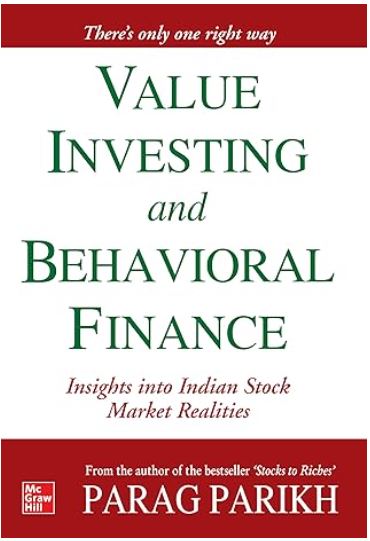The Reading Room

Value Investing and Behavioral Finance: Insights into stock market realities
Parag Parikh
Published: 2017, McGraw Hill Education
Veteran Value Investor Parag Parikh’s book “Value Investing and Behavioral Finance” is a Bible for investors seeking to compound their money over the long run. Especially for amateur investors (like me) from India, the book serves well because Mr Parikh has given many Indian examples to elucidate concepts.
Investing is the blend of science, art and craft and those who get this alchemy right outperform the market over the longer term. In this context the book focuses on the art through the lens of behavioral finance where the investor, be it retail or institutional, must have the right temperament and EQ (emotional quotient).
Behavioral biases such as loss aversion, group thinking, confirmation bias, endowment effect etc. cloud judgement resulting in poor decision making and thereby poor returns. Mr. Parikh’s explanations of how these biases can lead to irrational investment decisions and market inefficiencies, opening our minds to opportunities for disciplined value investing across the cycles of the stock market in the long run.
Mr. Parikh urges investors to be cautious on IPO investing; asking thought provoking questions such as why isn’t there an IPO in a bear market? Why do companies come with an IPO when they have the best results? He also provides statistics to show that most IPOs underperform post listing and investors are doing damage to their investments by falling prey to the greater fool theory and the novelty allure of IPOs.
I found the chapter of Index Investing to be unique given that unlike most, Parag Parikh believes that index investing shouldn’t be practiced. He says that inclusion of a stock in the index leads to bumped up prices, and market capitalization is a very naïve reason to buy that stock. Plus, institutional imperatives force most seasoned money managers to focus largely on large caps that carry substantial weight in the index leaving plenty of stocks that are out of the index and may have a more promising future with much lower risks.
Mr. Parikh eschews growth at all costs. Reasonable valuations are the key. As Mr. Buffett says “Price is what you pay, value is what you get.” He gives many examples to support where he states that chasing a high growth sector at 3-digit PEs regardless of the growth leads to wealth destruction. Infosys is a case in point where the stock was trading at 110x PE at the peak of Dot com boom in 2000 and took 6.5 years to get back to the same price despite stellar growth and margins! On the contrary, he recommends one to be a smart contrarian e.g. VST Industries that falls into sector having lower growth rate and valuations but with market share gains and inelastic demand for cigarettes could lead to enormous wealth creation
This an insightful book that provides the right framework for investors to not be emotional and make snap decisions as well as have a long term value investing approach. It is remarkable because the focus is on eliminating stupidity than seeking brilliance. Reminds me of the late Charlie Munger’s quote “It is remarkable how much long-term advantage people like us have gotten by consistently not stupid than to be intelligent.”
If investors follow these lessons, they will be richer, happier and wiser. Happy Investing.
Jainam Vora
September 2024
The information contained above and in other entries in the Ocean Dial Book Review Series is intended for general information and entertainment purposes only, and should not be relied upon in making, or refraining from making, any investment decisions. No information provided herein should or can be taken to constitute any form of advice or recommendation as to the merits of any investment decision. You should take independent advice from a suitably qualified investment adviser before making any investment decisions.
Chip War – The Fight for the World’s Most Critical Technology
Published: 2022, Simon & Schuster
Power in the modern world – military, economic, geopolitical – is built on a foundation of computer chips. America has maintained its lead as a superpower because it has dominated advances in computer chips and all the technology that chips have enabled. Now that edge is in danger of slipping, undermined by the naïve assumption that globalising the chip industry and letting players in Taiwan, Korea and Europe take over manufacturing serves America’s interests.
Poor Charlie’s Almanack: The Essential Wit and Wisdom of Charles T. Munger
Published: 2023, Stripe Press
From 1733 to 1758, Benjamin Franklin, the Founding Father of the United States of America, dispensed useful and timeless advice through his book Poor Richard’s Almanack (“Poor Richard” being the pseudonym adopted by Benjamin Franklin for this purpose). Among the virtues extolled were thrift, duty, hard work, and simplicity. Then some two and fifty hundred years later Charlie Munger stepped forth with Poor Charlie’s Almanack, a collection of speeches and talks by Charlie Munger first published in 2005.
The Ride of a Lifetime
Published: 2019, Transworld Publishers
Robert Iger became CEO of The Walt Disney Company in 2005, during a difficult time. Competition was more intense than ever and technology was changing faster than at any time in the company’s history.


